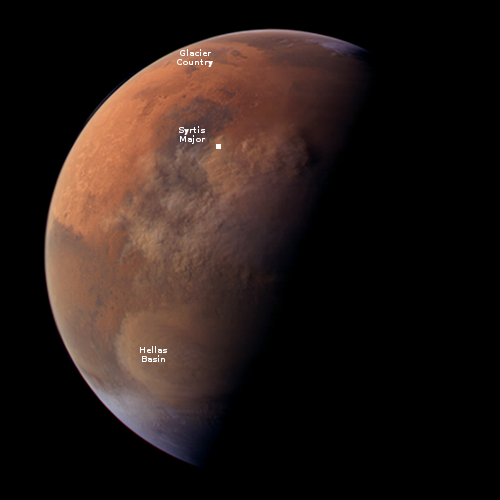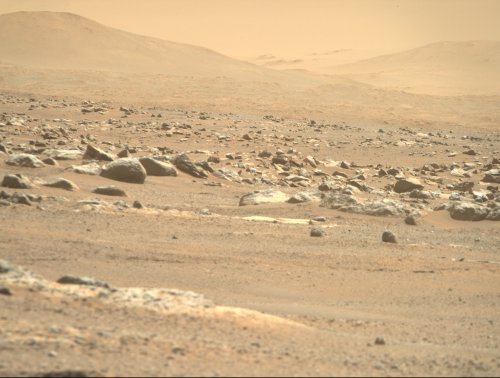Global image of Mars from UAE’s Al-Amal orbiter
Cool image time! The United Arab Emirates (UAE) today released several new images taken by its Al-Amal Mars orbiter, showing the changing atmospheric conditions on Mars between September ’21 and January ’22.
The photo to the right, cropped and annotated by me, is the January image, showing the dust storm conditions that presently exist in the equatorial regions of Mars. The lighter puffy cloud-like features in the center of the image are a 1,500 mile wide dust storm centered on the equator. The white dot indicates the approximate spot where Perseverance sits in Jezero Crater, within that storm.
The previous Al-Amal image from September (available at the link) shows the whole Martian hemisphere with generally clear skies.
Below is a recent photo taken by Perseverance illustrating these dusty conditions.
The photo to the right, cropped and reduced to post here, was taken on February 10, 2022 by one of the rover’s high resolution cameras, and appears to be looking to the west at the rim of Jezero in the distance. As you can see, the view is extremely hazy.
While dusty conditions such as this caused the end of the Opportunity rover, and are about to end InSight’s mission, both those probes depended on solar panels for power. Thus, dust and lower lighting conditions cut the power available to both landers, to the point that both could no longer operate.
Perseverance does not depend on solar power, however, but a form of nuclear power, so this dust storm had no significant impact on its operations. Ingenuity however does use solar panels, and it is this dust storm that caused the month-long delay in the helicopter’s 19th flight as engineers waited for the Martian air to clear.
On Christmas Eve 1968 three Americans became the first humans to visit another world. What they did to celebrate was unexpected and profound, and will be remembered throughout all human history. Genesis: the Story of Apollo 8, Robert Zimmerman's classic history of humanity's first journey to another world, tells that story, and it is now available as both an ebook and an audiobook, both with a foreword by Valerie Anders and a new introduction by Robert Zimmerman.
The print edition can be purchased at Amazon or from any other book seller. If you want an autographed copy the price is $60 for the hardback and $45 for the paperback, plus $8 shipping for each. Go here for purchasing details. The ebook is available everywhere for $5.99 (before discount) at amazon, or direct from my ebook publisher, ebookit. If you buy it from ebookit you don't support the big tech companies and the author gets a bigger cut much sooner.
The audiobook is also available at all these vendors, and is also free with a 30-day trial membership to Audible.
"Not simply about one mission, [Genesis] is also the history of America's quest for the moon... Zimmerman has done a masterful job of tying disparate events together into a solid account of one of America's greatest human triumphs."--San Antonio Express-News
Cool image time! The United Arab Emirates (UAE) today released several new images taken by its Al-Amal Mars orbiter, showing the changing atmospheric conditions on Mars between September ’21 and January ’22.
The photo to the right, cropped and annotated by me, is the January image, showing the dust storm conditions that presently exist in the equatorial regions of Mars. The lighter puffy cloud-like features in the center of the image are a 1,500 mile wide dust storm centered on the equator. The white dot indicates the approximate spot where Perseverance sits in Jezero Crater, within that storm.
The previous Al-Amal image from September (available at the link) shows the whole Martian hemisphere with generally clear skies.
Below is a recent photo taken by Perseverance illustrating these dusty conditions.
The photo to the right, cropped and reduced to post here, was taken on February 10, 2022 by one of the rover’s high resolution cameras, and appears to be looking to the west at the rim of Jezero in the distance. As you can see, the view is extremely hazy.
While dusty conditions such as this caused the end of the Opportunity rover, and are about to end InSight’s mission, both those probes depended on solar panels for power. Thus, dust and lower lighting conditions cut the power available to both landers, to the point that both could no longer operate.
Perseverance does not depend on solar power, however, but a form of nuclear power, so this dust storm had no significant impact on its operations. Ingenuity however does use solar panels, and it is this dust storm that caused the month-long delay in the helicopter’s 19th flight as engineers waited for the Martian air to clear.
On Christmas Eve 1968 three Americans became the first humans to visit another world. What they did to celebrate was unexpected and profound, and will be remembered throughout all human history. Genesis: the Story of Apollo 8, Robert Zimmerman's classic history of humanity's first journey to another world, tells that story, and it is now available as both an ebook and an audiobook, both with a foreword by Valerie Anders and a new introduction by Robert Zimmerman.
The print edition can be purchased at Amazon or from any other book seller. If you want an autographed copy the price is $60 for the hardback and $45 for the paperback, plus $8 shipping for each. Go here for purchasing details. The ebook is available everywhere for $5.99 (before discount) at amazon, or direct from my ebook publisher, ebookit. If you buy it from ebookit you don't support the big tech companies and the author gets a bigger cut much sooner.
The audiobook is also available at all these vendors, and is also free with a 30-day trial membership to Audible.
"Not simply about one mission, [Genesis] is also the history of America's quest for the moon... Zimmerman has done a masterful job of tying disparate events together into a solid account of one of America's greatest human triumphs."--San Antonio Express-News




Bob,
Is the plan for all Mars probes going forward to be powered by nuclear sources. Would seem insane to me to send something into that environment which was reliant on solar power.
Too bad there’s no mechanism provided for Ingenuity to return and get a recharge boost from Perseverence’s nuclear power, if needed. Or at least provide a blower on Perseverence that could blow off Ingenuity’s solar panels as Perseverence drives over it.
Just wondering- should a dust devil come along and blow the dust off of Opportunity, could it actually wake up?
Andi: No. Opportunity is dead. Once its power dropped so low that it could no longer maintain the instruments at a certain temperature, they froze.
Robert:
Might it be possible that Opportunity might have been buried completely (or partially), when that global dust storm hit it?
Lemuel Ricafort Vargas: No. The amount of material in a Martian dust storm is quite small. Remember, the atmosphere is 1/1000th as thick as Earth’s. The dust can block sunlight during a storm, and it can reduce the efficiency of a solar panel significantly, but neither requires very much dust.
As the pic at top illustrates, the quantity of sunlight being “blocked” isn’t large, together with the crater wall dozens of miles away being still visible, so the quantity of dust suspended in the air really isn’t all that much.